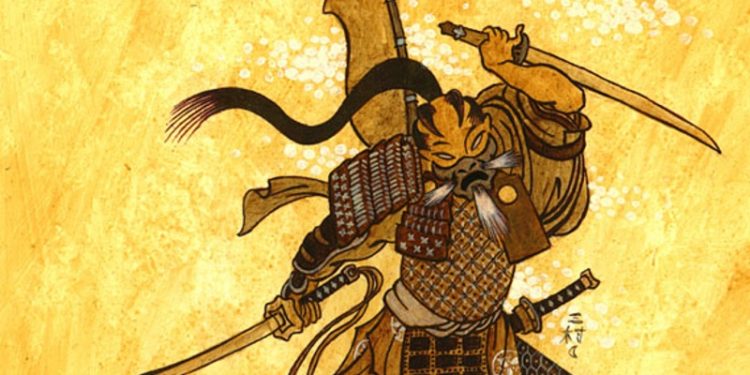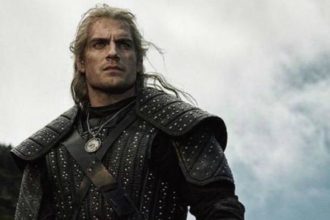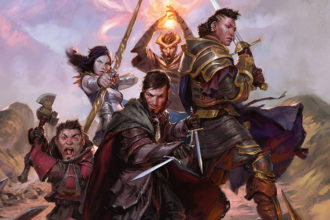The Monk Class, Part Eight

At a reader’s request, I’m going back to the 3.0 Oriental Adventures and covering the monk prestige classes found there. In this series’ broader conversation on monks, this and the 1e Oriental Adventures are our only examples of settings that explicitly do suit monks, without even a whiff of Eurocentrism. Because it embraces Rokugan, OA and its monks lean heavily toward mythic Japan rather than mythic China or India. Some of the other OA classes are more appropriate to mythic China, such as the wu jen, and WotC released an electronic supplement for mythic India, Mahasarpa (link goes to a PDF).
Part One | Part Two | Part Three | Part Four | Part Five | Part Six | Part Seven | Part Eight
The Baseline Monk
Monks in Oriental Adventures receive subtle mechanical tweaks and vast, if backhanded, thematic shifts. Keeping in mind that Rokugan – that’s the Legend of the Five Rings setting – is the default 3.0 OA setting, not only are monks not getting shoehorned into a fantasy-medieval-Europe pastiche, they’re painted as deliberate outsiders of Rokugan’s clan-first society, in a setting where clan affiliations and social rank are the most important part of all character interactions. Oh, sure, monks are outsiders in the core D&D default setting too, but D&D’s default settings tend to be anachronistically egalitarian – outsiders are more often judged on merit than their existing social ties. It’s a world where status matters, and monks neither have any nor accrue any.
On to the mechanics:
- Knowledge (religion) is added to the monk class skill list. Its absence is more like an error in the original monk, to my mind.
- OA introduces more Asian weaponry, and gives monks proficiency in some of them – such as the butterfly sword, the jitte, and the tonfa. Looking at the full list of new weapons, a lot more of them should have made it to the monk list, but I am a big fan of big (war) fans. Also I really like the 5e monk’s comparatively generous all simple weapons are monk weapons, plus shortswords, because for the love of… an endless quest for enlightenment, it meant that someone was happy when I handed out a magic spear last session.
- Instead of being locked into Stunning Attack, Deflect Arrows, and Improved Trip as their bonus feats, monks can choose from lists determined by their martial arts forms. Confusingly, martial arts forms are not the same as – hell, barely related to – martial arts styles.
- What’s a martial arts form, and how do you pick one? A form is categorized at the top level as hard, hard/soft, soft, or mental training. Hard forms favor Power Attack, soft forms favor Expertise, and the other two categories have no opinion on the matter. Some forms are further divided into methods, and these methods are lists of feats.
- What’s a martial arts style, and how do you pick one? That’s a lot less clear than it should be, but in brief, a style is a collection of feats, plus a skill or two. When you pick up enough of those feats and skill ranks, you can buy a style mastery feat for an added benefit. It’s 3.x, and feats are the linchpin of the design. You’re generally looking at qualifying for the style mastery feat around 6th level, if you go for it as hard as possible.
- Monks multiclass freely here. I assume there were some great design fights over that one.
- But it’s not entirely straightforward to do so, because your base attack bonus from classes that aren’t monk or monk-focused prestige classes interacts oddly with the monk’s special approach to iterative attacks. It’s… messy. I can see a lot of DMs landing on “okay yes technically you can do that, but please, for the love of an endless quest for enlightenment, don’t.”
To my mind, this is a good postscript editing pass on the monk, plus a bunch of mechanics-first faffing about that. Reading the whole section on martial arts forms and styles only suggests to me that I’d like to see monks written up as a subclass or variation within fighter. Probably all fighters should get some kind of better-than-1-damage brawling option, because I’m pretty sure that is part of the image and fantasy of fighters, so the rest of the absolutely-necessary monk features get loaded into the subclass. Treating the ki pool as more different Combat Superiority is pretty one-and-done, right?
But I digress. Let’s talk about the monk prestige classes. The Tattooed Monk is all but unchanged and won’t get more page-space here, except to say that Oriental Adventures has no interest whatever in spilling the beans on the ultra-cool secret backstory of L5R’s Tattooed Monks. Way to bury the lede, y’all. Don’t get me wrong, I appreciate uncovering secrets during play more than damn near anyone, but when the presented flavor text is utterly generic and offers no hint of the coolness, probably no one will ever find out the rockin’ awesome backstory.
…I digressed again. Look, if you’ve been reading my column here for any length of time, you should just know that’s the flavor it comes in.
Henshin Mystic
The henshin mystic is about enlightenment by awakening divinity within, which apparently involves a lot of perception and fire-related features, as well as picking up a decent number of the core monk features they’d be missing, like Diamond Body, Ki Strike, Empty Body, Timeless Body, and most of the effects of Perfect Self. The names of the features imply a trickster-monk, but the rest of the text backs off that.
- d8 Hit Dice.
- 11th level is the earliest you can enter the class, since it requires 13 ranks of Knowledge (Religion). The 6 ranks of Knowledge (Arcana) are sort of an odd choice. In theory you could stop at Monk 5 and do something else for your next 5 levels, but… you probably shouldn’t, at least within a strict 3.0 context.
- 4 + Int skill points per level, with a more magic-themed twist to the core monk list (Scry, Spellcraft).
- Riddle of Awareness lets you cast scrying once per day without expending a spell slot or using any material or focus components. It also grants a very nice +4 boost to Listen, Scry, Search, and Spot. Considering that Henshin Mystic 1 was the first time you could really buy Scry without going cross-class, and you still don’t have Search or Spot in-class, this is quite good.
- Blind-Fight is a bonus feat for you at 2nd level.
- Diamond Body is also at 2nd level, so it’s functionally delayed by one character level.
- Happo Zanshin at 3rd level grants you a non-stacking Uncanny Dodge. That’s not nearly as impressive in a prestige class (since it just uses your henshin mystic level) as it is with rogues and barbarians, but what can you do? It’s still handy.
- Root the Mountain is short-term (1 round per level) immunity to every kind of forced movement, including Here again, rounds-per-level scaling is unlovely in a prestige class, but this is a pretty great effect all the same. Better, probably, in 4e and 5e, where forced movement is more prevalent.
- Riddle of Interaction is an outlier in the whole collection of features. Three times per day, the monk can cast charm monster. Um, sure? And the DC is determined by the monk’s Charisma? Come on, now. (This probably makes a lot more sense in L5R than in 3.0 translation.) This feature also grants a +4 bonus to the full boat of interaction skills; once again, only one of those is in-class for the monk or the henshin mystic. There’s an argument to be made that the +4 bonus still isn’t pushing your modifiers high enough to achieve anything, but I don’t think we can ask this prestige class to solve DC scaling.
- Ki Strike works as normal for the monk, though this only scales up to +2; however, it stacks with monk levels for higher enhancement equivalency.
- Touch of Fire grants three uses of heat metal per day. This is probably never a good use of the character’s action, at least not for the spell’s combat applications. You’re a 15th-level character, act like it.
- Blindsight out to a range of 30 feet. This is super good.
- Hitsu-Do causes your eyes to glow and your melee attacks to deal an extra d6 fire damage. This lasts 2 rounds per henshin mystic level. Considering how many attacks you’re making at 16th level, this is a big deal. The rounds of duration can’t be split up over the course of a day, though, which is a shame.
- Riddle of Flame grants one fire shield per day that also adds the fire shield’s damage value to the monk’s unarmed strike damage, but explicitly does not stack with Hitsu-Do. If Hitsu-Do is good, this feature is stellar.
- Timeless Body shows up at 8th level.
- Walk Through Mountains grants 2 rounds of etherealness per day. This duration can be broken up into multiple sessions of use.
- Riddle of Invulnerability is Perfect Self, without all the complication of becoming a (native) outsider.
Well, a fire monk that does fire things and also has strong perception features is good times. This mostly avoids feeling like a grab-bag, and I like the parts of the monk’s high-end features that it retains. I can easily see how this would be fun to play, though I’m not wild about how much duration and currency management goes on. That’s totally normal for high-level 3.x characters, of course.
Shintao Monk
I guess the first thing to know here is that Rokugan has its own badass-heroic origin story for Taoism, but otherwise lifts Taoism pretty much whole-cloth. The founder of Taoism in Rokugan was Shinsei, who had many badass awesome adventures in the mythic past, and now provides an example for monks, samurai, emperors, and everyone else. The overall style of the Shintao monk is probably deeply mystical in L5R, but in the magic-is-everywhere context of D&D, it doesn’t stand out – and thus doesn’t have “it’s the spiritual one with weird effects” as any kind of unifying theme, and D&D doesn’t have an explicit concept of Void as an element that does cool stuff. This is the version of the monk that is all about beating the crap out of the Shadowlands, so that’s all to the good.
- d8 Hit Die, of course.
- Qualifying for Shintao monk is comparatively easy – Monk 6 or Monk 3/Fighter 2 cover it nicely. I can at least see why there’s an alignment restriction here, though “my student was secretly evil and just in it for the kewl powerz” is one of the quintessential martial arts tales. There is a strict code of conduct, as one might expect of monastic vows, but we don’t usually see in monk class writeups.
- 4 + Int skill points per level, with a list that looks a lot like the henshin mystic’s. Giving the monk more class skills without boosting their skill points is right at the edge of being a sick joke, at the player’s expense.
- Touch the Void Dragon (not a euphemism for sex or drugs, because Shintao monks don’t have fun) grants a once-per-day casting of the 1d4+1-to-an-ability-score spells. This is 3.0 and not 3.5, so fox’s cunning, owl’s wisdom, and eagle’s splendor don’t yet exist – the rules instead reference potions of Intelligence, Wisdom, and Charisma. I wouldn’t say that this 1/day buff makes the 1st level of the Shintao monk all that satisfying, even with a bonus feat packed in with it.
- A bonus feat at 1st, 3rd, 5th, 7th, and 9th levels, with options drawing heavily from the new martial arts feats in OA. Picking up feats at a fighter-like rate is super rare in 3.x, so this amounts to a big deal over the course of the prestige class.
- Detect Taint is detect evil, but for Rokugan, and works at-will.
- This will be my one and only acknowledgement of all of you out there snickering about the taint.
- Smite Taint works just like 3.0 smite evil, which is to say not all that well. It’s another 1/day ability.
- Speak to the Soul is a 1/day detect magic. Kiiinda getting tired of ticking off a ton of 1/day utilities.
- Grasp the Earth Dragon is still not a euphemism, but a poetic way of saying “immunity to stunning, sleep spells and effects, and slow spells and effects. Since you’re getting this instead of Diamond Body, then… sure, I guess. Trading one set of immunities for another is, at least, not a net gain in player immunities.
- Purity of Shinsei is, and I am not making this up, a 1/level/day light Gee golly, that is swell. And by swell I mean, “mighty fancy for being damned close to useless.”
- Channel the Fire Dragon is a 1/day protection from elements (fire or cold).
- Great Silence is for when those stupid novices are breaking their vows of silence, I guess? Or when that pesky caster just will not shut up. It’s another effect that uses a monk’s Charisma modifier, for whatever reason. Folks, Charisma is not their deal, and multiple attribute dependency is a problem. This is a 1/day gaze attack, and if the target fails its save, it’s mute for 1 minute per level of the monk. Nice knowing you, caster bro – but at least almost all spellcasters are good at Will saves.
- Steal the Air Dragon probably is a euphemism, and in this case is a 1/day improved invisibility.
- Ancestral Guidance is a 1/week commune with greater spirit that does not have to pay the XP cost. Dodging XP burn is always good, even if you can’t use the feature very often.
- Ride the Water Dragon heals you 1 hit point per hour, even when you’re not resting. In 3.0, this is an insanely good natural healing rate, though if you’re more accustomed to 4e and 5e, you’re probably wondering if this is some sort of penalty. But no: before 4e, all forms of natural healing are insanely slow and punitive, even when hit points totals are vast.
- Kukan-Do is another 1/day gaze attack that forces a Will save against a DC determined by the monk’s Charisma. If the target fails, both characters cannot use any spells, spell-like abilities, or supernatural powers. But, well, one of you is still a monk and can beat the bejesus out of the other just fine, thankyouverymuch.
Taken together, the Shintao monk’s elemental dragon theme is really cool, but woefully undersold in its huge collection of 1/day features. The story of the five elemental dragons and top-notch martial arts training (i.e., five bonus feats) defending Rokugan from the horrors of the Shadowlands works for me just fine. The core gameplay is scattered, though – these features don’t suggest much about an approach to challenges. Compare this to the henshin mystic, which is all about beating enemies to death with fire damage in various formats. I like that there are utility powers and it’s not another class that is pure combat, at least.
The henshin mystic, Shintao monk, and tattooed monk are headlining examples of how prestige classes should feel. They have rich stories, organizational backing, and meaning in the setting – I like that henshin mystic is not just the class name, but also how literally everyone would describe that monk’s vocation. Because they do provide mechanical continuity with the monk in so many regards, they scan as being a lot more like subclasses that you don’t choose until later in your career. For the most part, their prerequisites are even pretty sane. They would both be strong foundations for new monk subclasses.
I’m now mostly sure that the next article in this series will cover the 5e monk. That may or may not be what I write for next week, because I am at times arbitrary like that.



